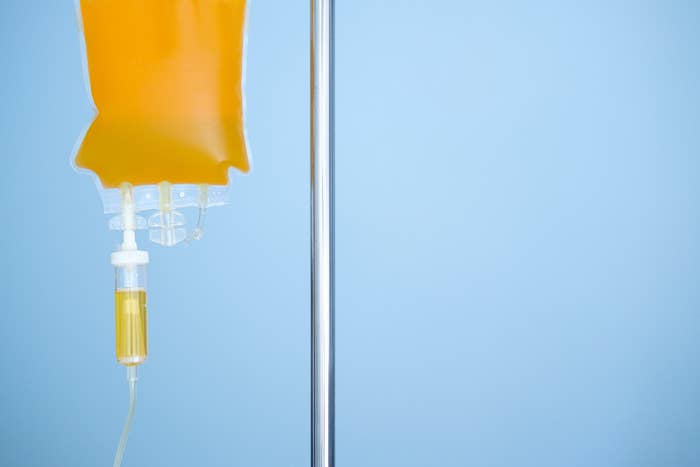
It should go without saying that getting poked by needles isn’t the most pleasant way to spend even 10 minutes of your time. But some people, like Kendall Jenner and Hailey Bieber, do it for hours at a time and consider the vein invasion a “really fun day,” according to last week’s episode of The Kardashians.
“Things like this, they comfort me,” Jenner says in the show. “They help because it just makes me happy and I don’t want anyone to judge me.”
While in Miami, the supermodel besties, lounging on cozy couches, rolled up their sleeves as a team of uniform-wearing professionals inserted intravenous lines into the insides of their elbows as part of a vitamin treatment known as IV therapy.
What is IV therapy?
In Jenner and Bieber's case, the IV therapy included NAD, or nicotinamide adenine dinucleotide, a coenzyme naturally found in the body that helps cells produce energy. These IV bags may also contain other vitamins and minerals that can be tailored to a person’s specific needs. Sometimes the fluid is bright yellow; these are called “banana bags.”
The vitamin treatment has been around for years but is gaining in popularity, particularly among celebrities, as a quick (and pricey) way to recover from hangovers and viruses, boost energy levels, achieve some mental clarity, combat jet lag, and acquire glowy skin or shiny hair. Adele, Chrissy Teigen, Simon Cowell, and Rihanna are just a few of the many high-profile people who’ve gone public with their use of IV vitamin therapies.
One session could cost anywhere between $350 to $800, depending on the ingredients, according to Ehsan Ali, a physician at and founder of Beverly Hills Concierge Doctor in California who administers these treatments. (Therapy prices generally won’t go lower than $100.)

IV therapy is touted as an efficient way to deliver fluid and nutrients into the body, pumping them directly into the bloodstream. Oral therapies like vitamin pills, on the other hand, must first be absorbed and broken down by the stomach, which takes more time and can limit how much of the nutrients a person actually receives. Ali pointed out that IV therapies used in a nonhospital setting are not intended to “treat anything,” but rather act as a supplement.
But many health professionals are not fans of this relatively new wellness trend, citing a lack of federal regulation and sound clinical research, as well as potential health risks for some people, particularly those with certain medical conditions.
For Jenner, who has been open about her occasional use of IV vitamin therapy for several years now, it helps bring a sense of control over her health.
“Literally since I can remember, I’ve been a hypochondriac, and so I am obsessed with health right now,” said Jenner, who has also been dealing with some “weird” post-COVID symptoms, too. “It’s been my number one priority, I’d say. To the point where I’m like eating myself alive thinking about my health.”
Does IV therapy work?
There’s little proof that IV vitamin treatments work, said Dr. Joshua Septimus, associate professor of clinical medicine at the Houston Methodist Research Institute in Texas, who called the therapy “nonsense.”
“It's the latest trend in functional or alternative medicine to kind of rip through the general community as a cure-all,” Septimus told BuzzFeed News. “It's just one more way to fleece people for money.”
One of Septimus’s biggest concerns is that IV vitamin therapies are not FDA regulated or approved, “so what you get is going to depend on where you go and who’s administering the snake oil,” he said, adding that no mainstream physician would recommend the treatment for anyone unless medically necessary.
Companies that provide them sometimes make unsupported and deceptive health claims about their vitamin cocktails. In 2018, the Federal Trade Commission for the first time cracked down on a company making health claims about IV treatments without scientific evidence.
The company, called iV Bars, operated drip clinics in Texas and Colorado at the time and claimed its IV vitamin therapies could treat cancer, multiple sclerosis, diabetes, congestive heart failure, fibromyalgia, and neurodegenerative disorders. It also claimed its cocktails “were more effective and better-tolerated than conventional medical therapies,” the FTC said.
The research on these infusions is also scarce. A handful of studies show moderate benefits for asthma, inflammation, and fatigue, while a larger batch found the treatments have little to no impact, particularly for more serious health conditions like acute respiratory distress syndrome, cancer, sepsis, and stroke. However, in the studies, people were given a variety of different vitamin therapies in medical settings.
The majority of research on IV vitamin therapies show the treatments can be administered safely in certain groups (though keep in mind some studies have small sample sizes) but don’t really have substantial benefits for specific conditions.
So why do some people feel better after IV vitamin therapy?
Ali of Beverly Hills said his clients typically feel better immediately after the vitamin infusion, which can last one to eight hours, depending on the chosen dosage.
While some people may certainly feel more refreshed after a treatment, Septimus is doubtful the vitamins are responsible.
Lying in a calm environment for a couple of hours while receiving the IV therapy will help anyone relax, he said, so there may be a placebo effect at play. (One 2009 study did conclude the placebo effect was likely a reason people with fibromyalgia felt relief after eight weeks of IV vitamin therapy.)
Not to mention if you’re dehydrated, IV therapy may help you feel better by filling your blood vessels with the fluids they need.
However, just because a certain treatment seems “biologically plausible,” either theoretically or in a test tube, it doesn’t mean the therapy actually works, Septimus said.
“The first thing you learn in medical school is ‘primum non nocere,’ which means ‘first do no harm,’” Septimus said. “But in order to first do no harm, you have to study something.”
Some people should absolutely avoid IV therapy treatments
The risks of IV therapy treatments depend heavily on the mixture of nutrients you receive, some of which can be potentially hazardous for people with certain medical conditions. Because the vitamin cocktails are not FDA regulated, you may not really even know what you’re getting.
For example, if your banana bag is brimming with calcium and you have an undiagnosed kidney insufficiency, you run the risk of developing blood clots in your arteries due to calcium deposits that “can be life threatening,” Septimus said.
Similarly, if you have any type of heart disease or condition, you should avoid IV vitamin treatments because the excess fluid may increase the risk of heart failure, a chronic condition where the heart struggles to pump enough blood.
If drip bags contain sugar solutions, people with diabetes should stay clear, Septimus added. Those with weakened immune systems should also never consider this kind of treatment (unless medically necessary) because in the event the needle isn’t properly sanitized or inserted, you can develop a dangerous infection.
People with liver disease should avoid this therapy at all costs too, Septimus said.
Do you really need all these vitamins anyway?
The first question you should ask yourself before swiping your credit card at an IV drip clinic or lounge is, Do I really need these vitamins?
Generally, nutritional deficiencies in the US are rare outside of serious medical situations like gastric bypass surgery or extreme diets, “so the fact is that most people don’t need vitamins that they’re not already getting from their food,” Septimus said.
For those who do have nutritional deficiencies, a multivitamin pill will usually suffice. And if you are so dehydrated that you need an IV drip, a nonmedical clinic may not be the best place to get treatment.
“If you are volume depleted enough that you need IV fluids, you should be under the care of healthcare professionals, not that of a mobile IV clinic that's giving people sham treatments,” Septimus said. “You really should be seeing a physician to get a prescription for that fluid. And most of the time if someone is unwell enough that they need volume repletion, they can do it orally.”
Even healthy people face some risks. Back in 2018, Jenner was hospitalized after experiencing a bad reaction to a vitamin IV drip, though the type of reaction or reason is unknown, People reported at the time.
Aside from possible infections from improper needle use (which can happen in both hospital and home settings), vitamin toxicity can occur. For example, if you take too much vitamin B6, which is associated with brain health and mood improvement, you can damage your nerves in a way that can lead to permanent numbness in your limbs.
It’s also possible to overdo it. Ali said this hasn’t happened to any of his clients, but that receiving IV vitamin therapy more than once a week “would be too much,” he said.
Your takeaway message, at least according to one physician: “Don't waste your money. Get your nutrition from food. Get your hydration through your mouth,” Septimus said. “And if you're sick enough that you need an IV, you need to be evaluated by a healthcare professional.”
